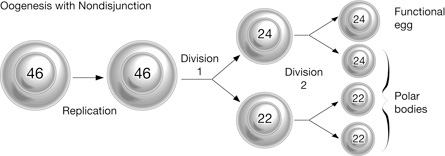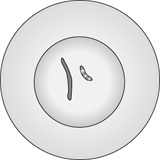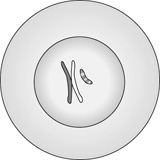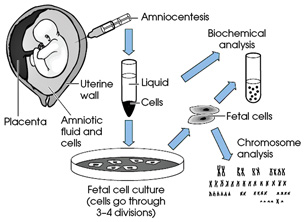Module 5
1. Module 5
1.23. Page 3
Module 5—Cell Division: The Processes of Mitosis and Meiosis
 Module 5: Lesson 5 Assignment
Module 5: Lesson 5 Assignment
Retrieve the copy of the Module 5: Lesson 5 Assignment that you saved to your computer earlier in this lesson. Complete Part 1. Save your completed assignment in your course folder. You will receive instructions later in this lesson on when to submit your assignment to your teacher.
 Self-Check
Self-Check
To ensure your understanding, complete the following questions on nondisjunction and abnormal meiosis and then check your answers. Ask your teacher for clarification of any concepts.
Carefully study this illustration and then answer the questions that follow.

SC 1.
- What has happened that is not normal? What is this process called?
- Sketch a normal gamete that should arise from the mother cell.
SC 2. Name three genetic disorders that are the result of nondisjunction.
Use the flow chart showing the results of nondisjunction in meiosis I to answer question 3.

SC 3.
- In which division has nondisjunction occurred?
- Why is the egg cell shown abnormal?
- If the cell with twenty-two chromosomes were to give rise to the egg, would the egg be abnormal? Explain.
monosomy: offspring that only have one of a particular chromosome rather than two; occurs when a normal n gamete fuses with an n − 1 gamete, producing a 2n − 1 zygote; in humans, an offspring that has a diploid number of 45 rather than 46
SC 4. Zygotes having an abnormal number of chromosomes are usually described by the terms monosomy or trisomy. What do these terms mean?
Assume the eggs that could be produced from the division shown in question 3 are fertilized as illustrated.

SC 5. Label each illustrated situation as either trisomy or monosomy.
SC 6. Identify the syndrome produced by each of the abnormal sex chromosome combinations shown in the chart.

SC 7. Some individuals may have the combination of sex chromosomes XXXY. What is the sex of this person? Explain why.
 Self-Check Answers
Self-Check Answers
SC 1.
a. One pair of homologous chromosomes did not separate, but instead the entire tetrad was pulled to one pole. This process is called nondisjunction.
b. A normal gamete would look like the cell below.

SC 2. Three genetic disorders are Down syndrome, Klinefelter syndrome, and Turner syndrome. There are many others.
SC 3.
a. Nondisjunction has occurred in division I.
b. The egg cell shown has one too many chromosomes.
c. Yes, it would be abnormal, because it would lack one of the chromosomes that make up the set of 23. It would be lacking some of the genetic information needed for the potential offspring to develop normally.
SC 4. Monosomy is a condition in which only one chromosome of a particular type occurs instead of the usual pair.
Only one of these should be present.

Trisomy is a condition in which three copies of a particular chromosome occur instead of the usual pair.
SC 5. Situation A represents trisomy. Situation B represents monosomy.
SC 6.
a. trisomy female
b. Turner syndrome
c. Klinefelter syndrome
d. Turner syndrome
SC 7. The sex of the person is male because the presence of the Y chromosome produces maleness regardless of the number of X chromosomes present.
 Read
Read
There is a dramatic increase in the incidences of nondisjunction in female gametes as a woman ages. For example, the chances of having a Down syndrome child at age 25 is 1:1500, by age 30 the risk is 1:910, and by the age of 45 it is 1:30. A specific cause for this is unknown.
As a woman ages, the oocytes have been suspended in prophase I for many years. The chances have increased that the apparatus to complete meiosis properly has deteriorated. New research also indicates that a woman’s womb can becomes less selective for genetically compromised embryos, making it more likely to carry an embryo with a genetic disorder to term.

Genetic Testing
Recall from your studies in Unit B the various technologies used to test a fetus for genetic problems. Three common procedures are amniocentesis, cordiocentesis, and chorionic villi sampling. Each differs in terms of when it can be done, which material it tests, and how quickly the answers come back. Each test is the same in terms of what is being looked for: an abnormal number of chromosomes.
amniocentesis: a needle sampling of fetal amniotic fluid to gather embryonic cells for karyotyping; determines chromosome number and gender, not presence of specific genes/alleles on chromosomes
cordiocentesis: a sampling of umbilical cord blood of a fetus for karyotyping
chorionic villus sampling (CVS): a sampling of chorionic villi through the vagina, used to obtain embryonic cells for karyotyping
 Try This
Try This
TR 2. Research the following genetic testing technologies and complete a table like the following. Share your work with your fellow students in the discussion area.
| Name | Description of Procedure | Advantages | Risks |
| Amniocentesis | |||
| Chorionic Villi Sampling | |||
| Cordiocentesis |
Ethical Concerns
Science is very good at seeking knowledge. However, it is not the role of science or even scientists to decide what should be done with that knowledge. Instead, this role falls on the shoulders of society. What are some ethical concerns that can arise from prenatal genetic testing? What is the tension or debate that focuses on prenatal testing? Use the discussion board to share ideas with your fellow students or discuss your ideas with your teacher.
Some groups within society may object to prenatal tests because of the possible risks to the fetus. Prenatal testing can jeopardize the pregnancy, for example, by resulting in a miscarriage or by introducing infection. Furthermore, based on the results of the testing, parents may choose to terminate the pregnancy.
blastocyst: the embryonic stage about one week after conception; a hollow ball of cells consisting of outer trophoblast that becomes the chorion and inner cell mass that becomes the embryo; implants in the wall of the endometrium
Stem cell research is another controversial issue. Some people and groups may have ethical concerns because of the certain death it causes to the blastocyst from which these cells may be taken.
 Module 5: Lesson 5 Assignment
Module 5: Lesson 5 Assignment
Retrieve the copy of the Module 5: Lesson 5 Assignment that you saved to your computer earlier in this lesson. Based on what you have read, the videos you have watched, and any research that you have done, complete Part 2. Save your completed assignment in your course folder. You will receive instructions later in this lesson on when to submit your assignment to your teacher.
 Watch and Listen
Watch and Listen
There is controversy about stem cell research. For information on Canada’s guidelines for research, search the Internet using the terms “cbc + archives + Canada’s guidelines + stem cell research” and watch the news documentary.